
HMS Kingfisher was a Doterel-class screw sloop of the Royal Navy. She was built at Sheerness Dockyard and launched on 16 December 1879. She conducted anti-slavery work in the East Indies in the late 1880s before being re-roled as a training cruiser, being renamed HMS Lark on 10 November 1892, and then HMS Cruizer on 18 May 1893. She was sold in 1919.

HMS Shearwater was a Condor-class sloop launched in 1900. She served on the Pacific Station and in 1915 was transferred to the Royal Canadian Navy as HMCS Shearwater, serving as a submarine depot ship until 1919. She was sold to the Western Shipping Company in May 1922 and renamed Vedas.

HMS Hornet was a 17-gun wooden screw sloop of the Cruizer class of the Royal Navy, launched in 1854 and broken up in 1868.

HMS Hyacinth was an 18-gun Royal Navy ship sloop. She was launched in 1829 and surveyed the north-eastern coast of Australia under Francis Price Blackwood during the mid-1830s. She took part in the First Opium War, destroying, with HMS Volage, 29 Chinese junks. She became a coal hulk at Portland in 1860 and was broken up in 1871.

HMS Hydra was the lead ship of her class of wooden steam paddle sloops of the British Royal Navy, launched in 1838 at Chatham Dockyard. After taking part in operations during the Syrian War in 1840, she then served on anti-slavery operations and also as a survey vessel. She was scrapped in 1870.
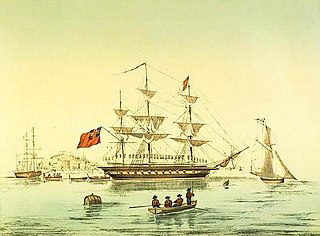
HMS Fly was an 18-gun sloop of the Royal Navy. She was responsible for the exploration and charting of much of Australia's north-east coast and nearby islands. She was converted to a coal hulk in 1855 and broken up in 1903.
HMS Highflyer was a 21-gun wooden screw frigate of the Royal Navy. She was built on the River Thames by C J Mare and launched on 13 August 1851. She spent twenty years in service, including action in the Crimean War and the Second Opium War, before being broken up at Portsmouth in May 1871.
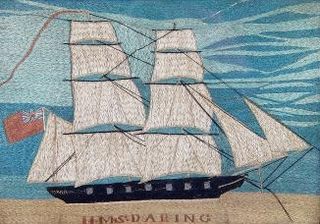
HMS Daring was a 12 gun-brig of the Royal Navy which became part of the Experimental Squadrons of both 1844 and 1845, and later served in the West Indies. She was sold in 1864.
Seven ships of the Royal Navy have borne the name HMS Peterel:
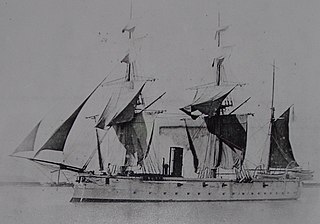
HMS Dryad was a 4-gun Amazon-class screw sloop, launched at Devonport in 1866. She served on the East Indies and North American Stations, taking part in the Abyssinian War, a confrontation with the French at Tamatave and the Egyptian War. She was sold for breaking in 1885.
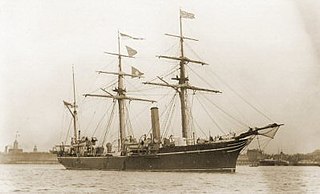
The Alert class was a two-ship class of 6-gun screw steel sloops built for the Royal Navy in 1894.

The Condor class was a six-ship class of 10-gun screw steel sloops built for the Royal Navy between 1898 and 1900. Condor foundered in a gale, prompting the Royal Navy to abandon sailing rigs for its ships; all the others in the class survived into the 1920s. The last of the class, Mutine, survived until 1932 as a Royal Naval Volunteer Reserve drill ship.

The Cadmus class was a six-ship class of 10-gun screw steel sloops built at Sheerness Dockyard for the Royal Navy between 1900 and 1903. This was the last class of the Victorian Navy's multitude of sloops, gunvessels and gunboats to be constructed, and they followed the traditional pattern for 'colonial' small warships, with a full rig of sails. After them, the "Fisher Reforms" of the Navy ended the construction and deployment of this type of vessel. All of the class survived until the 1920s, remaining on colonial stations during World War I.
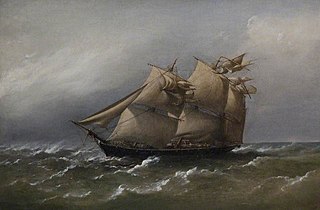
HMS Fawn was a Royal Navy 17-gun Cruizer-class sloop launched in 1856. She served on the Australia, North America and Pacific stations before being converted to a survey ship in 1876. She was sold and broken up in 1884.
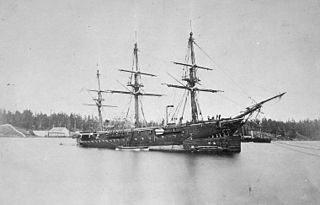
HMS Charybdis was a 21-gun Royal Navy Pearl-class corvette launched on 1 July 1859 at Chatham Dockyard.
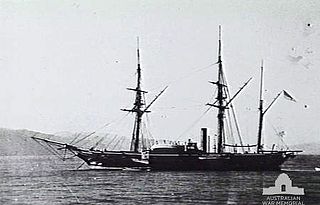
HMS Virago was a Royal Navy Driver-class wooden paddle sloop launched on 25 July 1842 from Chatham Dockyard.

HMS Peterel was a 16-gun Pylades-class ship-sloop of the Royal Navy. She was launched in 1794 and was in active service until 1811. Her most famous action was the capture of the French brig Ligurienne when shortly after Peterel captured two merchant ships and sent them off with prize crews, three French ships attacked her. She drove two on shore and captured the largest, the 14-gun Ligurienne. The Navy converted Peterel to a receiving ship at Plymouth in 1811 and sold her in 1827.
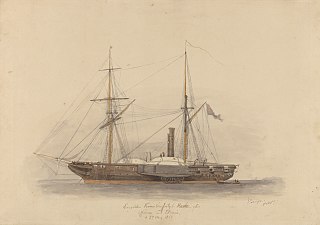
The Hydra class were a class of three paddlewheel steam sloops of the British Royal Navy. They saw active service variously in the Baltic during the Crimean War, against Ottoman forces in Syria and against slavers in West Africa. Latterly, Hydra and Hecate were used for surveys in the Mediterranean, the Pacific, Australia and the Atlantic, and thus their names were re-used for the Hecla-class survey vessels in the late 20th century. Two of the classes were broken up after more than twenty-five years of service, and Hecla was sold for commercial use in 1863.

HMS Peterel was a Rosario-class sloop of the Royal Navy.

HMS Growler was a paddle-driven Driver-class sloop, built in 1841 and broken up in 1854. In 1847 she carried liberated Africans to Sierra Leone for resettlement.


















